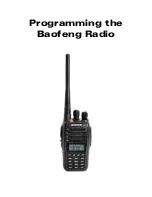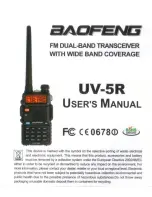
Page 9
FEaTURES FaMiLiaRizaTiOn
Multi-Function LCD:
The heart of the programming and display features of the transmitter. All programming and transmitter
display functions are shown on the Multi-Function LCD.
Navigation Pad:
The Navigation Pad is used in conjunction with the Programming Keys to facilitate transmitter programming.
The Navigation Pad allows you to quickly and easily move the Programming Cursor up and down, and right and left. The ENTER
key in the center of the Navigation Pad is used to open the selected menu or programming option.
Neck Strap Anchor:
Used to attach your neck strap (available separately) to the transmitter.
Power Indicator:
Indicates that there is power to the transmitter. When the battery voltage drops to 6.7 volts, the audible Low
Voltage Alarm will sound. For more information, see the Transmitter Alarms section below.
Power Switch:
Turns the transmitter ON and OFF.
Programming Keys:
The Programming Keys are used to facilitate transmitter programming and select models stored in
memory. The four Programming Keys consist of the INC+/M1 (Increase/Model 1) key, the DEC-/M2 (Decrease/Model 2) key, the
END/M3 (End/Model 3) key, and the F-MODE (Flight Mode) key.
Rudder Trim Switch:
Used to control
the Rudder axis Right and Left trim.
Throttle/Rudder Control Stick:
Controls the Throttle and Rudder axes. The Throttle/Rudder Control Stick length is adjustable
to suit your preference. For more information, see page 19.
Throttle Trim Switch:
Used to control the Throttle axis Up and Down trim.
Trainer Port:
The Trainer Port is where the trainer cable (available separately) is plugged into. An adapter to use the transmitter
with a flight simulator can also be plugged into the Trainer Port.
RF Output Indicator:
Illuminates when the transmitter is turned ON and transmitting a signal. If the RF Output Indicator fails
to illuminate, RF output is limited or non-existent. In this case, you should not fly. The RF Output Indicator will flash when the
transmitter Trainer mode is set to Slave.
FEaTURES DEScRiPTiOnS, cOnTinUED....
The 92224 (RX600) 6-Channel receiver included with your SD-6G 2.4GHz FHSS-1 radio control system uses universal Airtronics
'Z' connectors which are electronically compatible with the servos of other radio control system manufacturers. The connectors
are rugged, but should be handled with care.
When unplugging the servo connector, it's best not to pull on the servo wire itself. This could result in damage to the servo
wire pins in the plastic plug. Always grasp the plastic connector itself.
SERvO cOnnEcTORS
- = Negative (Black)
+ = Positive (Red)
S = Signal (Blue)
The SD-6G transmitter is equipped with several safety alarms to warn you of an abnormal transmitter condition.
TRanSMiTTER aLaRMS
Low Voltage Alarm
The SD-6G transmitter is equipped with a Low Voltage Alarm to warn you when the transmitter batteries need to be replaced or
recharged. The Low Voltage Alarm will sound when the transmitter batteries reach 6.7 volts. If the Low Voltage Alarm sounds
while you are flying, you should land immediately, then replace or recharge the transmitter batteries. If the Low Voltage Alarm
sounds after replacing or recharging the transmitter batteries, there may be a problem with the transmitter. If this occurs, please
contact Airtronics Customer Service using the information on the back cover of this Operating Manual.
Flight Mode Warning Alarm
The SD-6G transmitter is equipped with a safety feature that will not allow you to use the transmitter if the Flight Mode is not set
to FN (Normal) when you turn the transmitter ON. If the Flight Mode is not set to FN when you turn the transmitter ON, the Flight
Mode Warning alarm will sound continuously, the RF Output Indicator will flash, and the LCD will read F-MODE NOT 'N' ! To clear
the Flight Mode Warning, set the Flight Mode to FN using the Flight Mode Switches (move both Flight Mode switches forward).
The LCD will read normally, the Flight Mode Warning alarm will cease, and RF Output Indicator will stop flashing.
GENERAL
Summary of Contents for SD-6G
Page 1: ...Page 1...










































